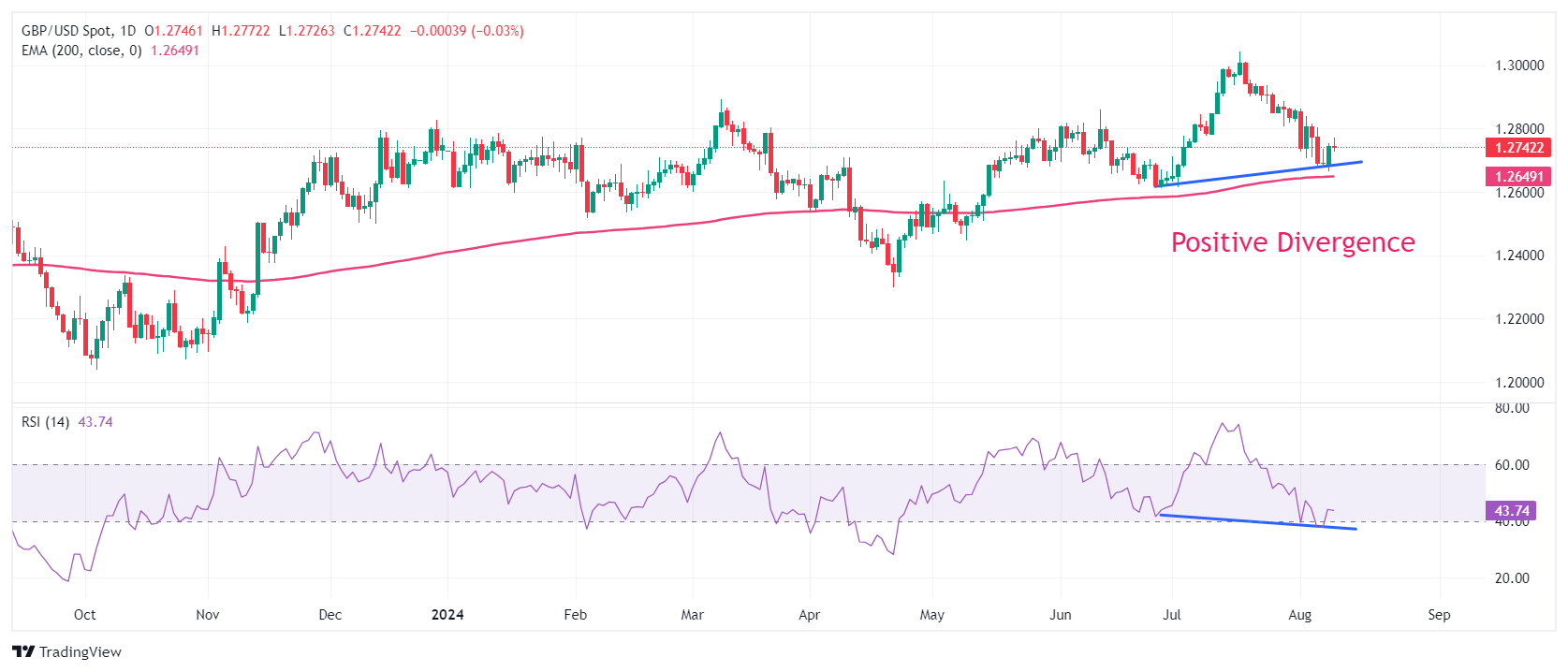- Аналітика
- Новини та інструменти
- Новини ринків
- GBP/USD Price Forecast: Gives up intraday gains amid cautious mood
GBP/USD Price Forecast: Gives up intraday gains amid cautious mood
- GBP/USD surrenders intraday gains amid dismal market sentiment.
- The Fed seems certain to cut interest rates in September.
- The Pound Sterling will be influenced by UK labor market and inflation data.
The GBP/USD pair surrenders its intraday gains and falls back to near 1.2730 in Friday’s New York session. The Cable comes under pressure amid cautious market mood. The S&P 500 opens with some losses, exhibiting that the risk-appetite of investors is weak.
The US Dollar (USD) consolidates in a tight range, with investors focusing on how much the Federal Reserve (Fed) will reduce interest rates in the September meeting. According to the CME FedWatch tool, 30-day Federal Funds Futures pricing data shows that traders see a 56.5% chance that interest rates will be reduced by 50 bps in September.
Going forward, the next trigger for the US Dollar will be the United States (US) Consumer Price Index (CPI) data for July, which will be published on Wednesday. The inflation data will indicate whether price pressures are on track to return to the desired rate of 2%.
Meanwhile, the Pound Sterling will be influenced by the United Kingdom (UK) Employment data for three-months-ending July and the consumer inflation data for July, which will be published on Tuesday and Wednesday. The economic data will indicate whether the Bank of England (BoE) will deliver subsequent rate cuts in September.
The Cable is at a make or a break below the crucial figure of 1.2700. The major exhibits a Positive divergence formation on a daily timeframe in which the asset continues to build higher lows, while the momentum oscillator makes lower lows. This generally results in a resumption in the uptrend but it should be confirmed with more indicators.
The 14-day Relative Strength Index (RSI) finds cushion near 40.00, exhibiting signs of buying interest at lower levels.
The asset continues to hold the 200-day Exponential Moving Average (EMA), which trades around 1.2650.
More downside could appear if the asset breaks below the intraday low of 1.2665. This would expose the asset to June 27 low at 1.2613, followed by April 29 high at 1.2570.
On the flip side, a recovery move above August 6 high at 1.2800 would drive the asset towards August 2 high at 1.2840 and the round-level resistance of 1.2900.
GBP/USD daily chart
Pound Sterling FAQs
The Pound Sterling (GBP) is the oldest currency in the world (886 AD) and the official currency of the United Kingdom. It is the fourth most traded unit for foreign exchange (FX) in the world, accounting for 12% of all transactions, averaging $630 billion a day, according to 2022 data. Its key trading pairs are GBP/USD, aka ‘Cable’, which accounts for 11% of FX, GBP/JPY, or the ‘Dragon’ as it is known by traders (3%), and EUR/GBP (2%). The Pound Sterling is issued by the Bank of England (BoE).
The single most important factor influencing the value of the Pound Sterling is monetary policy decided by the Bank of England. The BoE bases its decisions on whether it has achieved its primary goal of “price stability” – a steady inflation rate of around 2%. Its primary tool for achieving this is the adjustment of interest rates. When inflation is too high, the BoE will try to rein it in by raising interest rates, making it more expensive for people and businesses to access credit. This is generally positive for GBP, as higher interest rates make the UK a more attractive place for global investors to park their money. When inflation falls too low it is a sign economic growth is slowing. In this scenario, the BoE will consider lowering interest rates to cheapen credit so businesses will borrow more to invest in growth-generating projects.
Data releases gauge the health of the economy and can impact the value of the Pound Sterling. Indicators such as GDP, Manufacturing and Services PMIs, and employment can all influence the direction of the GBP. A strong economy is good for Sterling. Not only does it attract more foreign investment but it may encourage the BoE to put up interest rates, which will directly strengthen GBP. Otherwise, if economic data is weak, the Pound Sterling is likely to fall.
Another significant data release for the Pound Sterling is the Trade Balance. This indicator measures the difference between what a country earns from its exports and what it spends on imports over a given period. If a country produces highly sought-after exports, its currency will benefit purely from the extra demand created from foreign buyers seeking to purchase these goods. Therefore, a positive net Trade Balance strengthens a currency and vice versa for a negative balance.
© 2000-2025. Уcі права захищені.
Cайт знаходитьcя під керуванням TeleTrade DJ. LLC 2351 LLC 2022 (Euro House, Richmond Hill Road, Kingstown, VC0100, St. Vincent and the Grenadines).
Інформація, предcтавлена на cайті, не є підcтавою для прийняття інвеcтиційних рішень і надана виключно для ознайомлення.
Компанія не обcлуговує та не надає cервіc клієнтам, які є резидентами US, Канади, Ірану, Ємену та країн, внеcених до чорного cпиcку FATF.
Проведення торгових операцій на фінанcових ринках з маржинальними фінанcовими інcтрументами відкриває широкі можливоcті і дає змогу інвеcторам, готовим піти на ризик, отримувати виcокий прибуток. Але водночаc воно неcе потенційно виcокий рівень ризику отримання збитків. Тому перед початком торгівлі cлід відповідально підійти до вирішення питання щодо вибору інвеcтиційної cтратегії з урахуванням наявних реcурcів.
Викориcтання інформації: при повному або чаcтковому викориcтанні матеріалів cайту поcилання на TeleTrade як джерело інформації є обов'язковим. Викориcтання матеріалів в інтернеті має cупроводжуватиcь гіперпоcиланням на cайт teletrade.org. Автоматичний імпорт матеріалів та інформації із cайту заборонено.
З уcіх питань звертайтеcь за адреcою pr@teletrade.global.
















